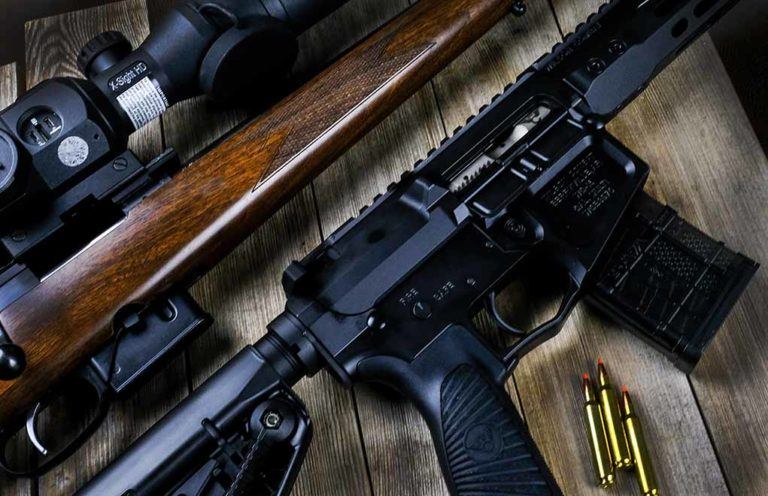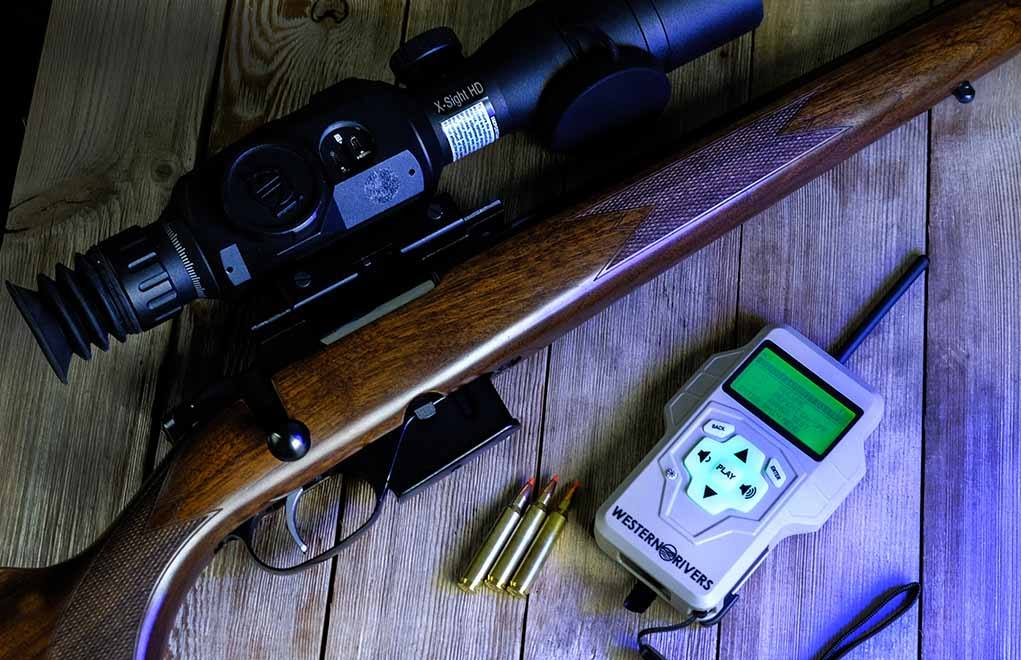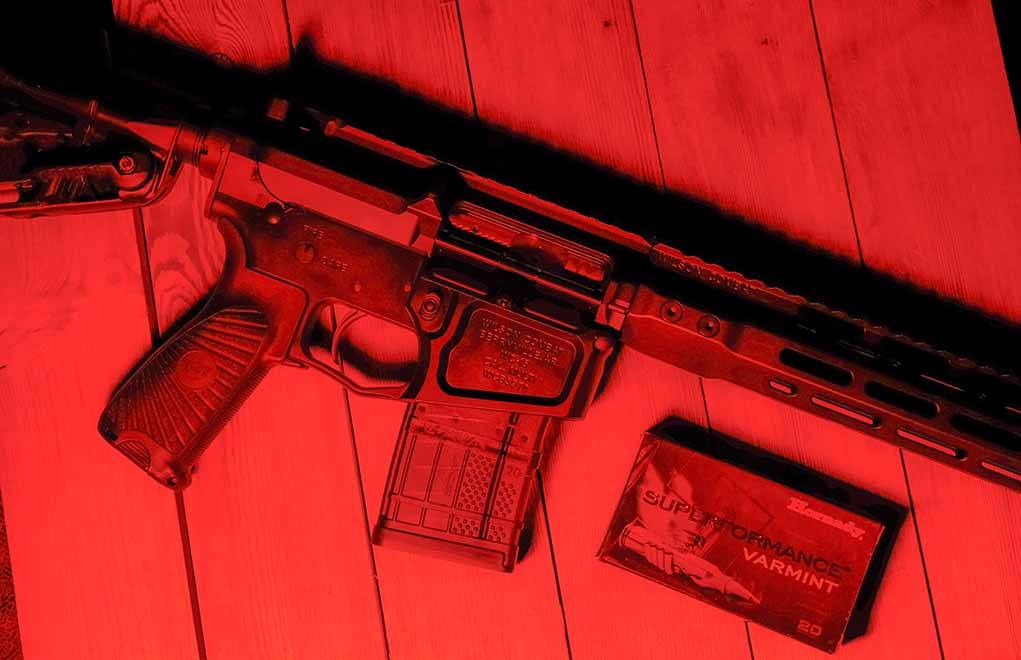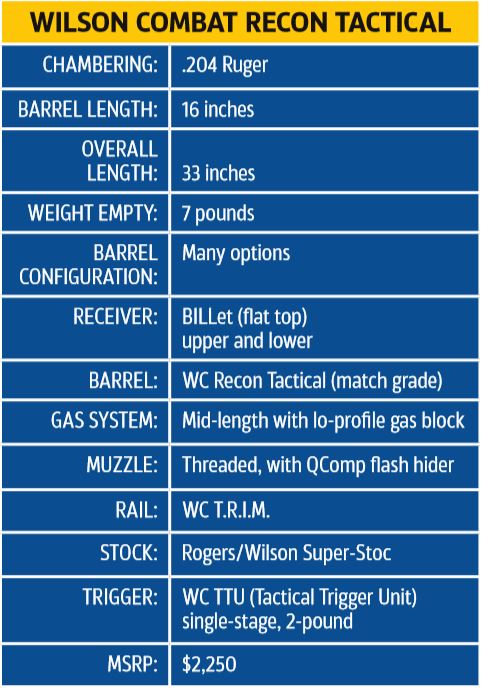
It’s fast, but do the ballistic numbers for the .204 Ruger measure up to its competition? You better believe they do and then some.
How the .204 Ruger Is Right On Target For Predator Hunting:
- Dead-flat shooter with a measly 28.1-inch drop at 500 yards.
- Small caliber does less damage to pelts retaining their value.
- .222 Remington Magnum case gives handloaders plenty of capacity in which to work.
- Excellent go-between from the Hornet class cartridges and the .22-250.
- Bearly a lick of recoil, making it extremely fast on follow-up shots.
If you’ve ever wondered if a meager bullet measuring only 5 millimeters in diameter and weighing a mere 40 grains matters, ask a coyote grave digger. Chances are good it’s helping keep him in business.
Much more than a coyote grave digger’s business development tool, that tiny polymer-tipped copper and lead song-dog sleeping pill sits atop a .204 Ruger case, and it’s as relevant today to predator hunters — and at the range for shooters who simply love speed — as it was when it debuted 45 years ago.

Technically, the .204 Ruger was created jointly by Ruger and Hornady in 2004. Hornady and Ruger based their 5mm hotrod on the .222 Remington Magnum case by simply necking it down to .204 inches, moving the shoulder forward and increasing its angle to 30 degrees.
I say “technically’ because I think the idea for the .204 Ruger actually began in California in 1960. You see, on May 16, 1960 —at the Hughes Research Laboratory — Theodore Maiman created the technology which I believe led directly to the development of this pint-sized coyote killer. Maiman, a physicist, operated the first device that emitted a beam of light amplificated by a stimulated emission of radiation. Physicists, unlike gun writers, don’t get paid by the word, so his creation’s name became shorter and simpler as an acronym: L-A-S-E-R. Today, we just call it a laser.
Laser? Really? Yes, really. In fact, if you don’t think “laser” when you think of the .204 Ruger, then, you my friend, don’t know the true personality of the .204 Ruger.

“Fast, flat and not fat, the .204 Ruger generally leaves one nice little hole,” said native Texan and Idaho guide and outfitter Brooks Murphy, who has hunted more than his fair share of pint-sized predators like coyotes and bobcats all over the United States. “It’s a great go-between from the Hornet-class cartridges to the .22-250 Remington without the risk of being associated with the ‘tacti-cool’ crowd at the range or in the field while eradicating rodent or predator problems.”
More Ammunition Information:
- The Blistering Hot 30 Nosler
- The .280 Ackley Improved
- If You Had To Pick Just One Cartridge, What Would It Be?
- Loading the .308 Winchester
The key laser-like word Murphy uttered was “flat.” Indeed, the .204 Ruger is remarkably flat considering it shoots a bullet propelled by hot gasses emitted from the burning of gunpowder and not a stimulated emission of radiation. After all, what other word would you use to describe a cartridge which, factory loaded, can give shooters a bullet with a measly 28.1-inch drop at 500 yards?
Targeting A Relevant Niche
The .204 Ruger’s reputation is quite relevant in the gun manufacturer’s community as well. When I needed a rifle and cartridge for some Virginia coyote hunting CZ-USA’s Zach Hein suggested I shoot a .204 Ruger based on its accuracy, range, ammunition availability and proven track record as a coyote killer nationwide. He focused on the fact that it’s got plenty of range to it, is quite accurate, and when it hits the critters it doesn’t ruin the fur as badly as other bigger cartridges.

Now, some of us don’t care if we blow coyotes up like watermelons hit by an AMTRAK train, but some people certainly collect and sell animal pelts, so massive wound channels or worse — coyotes blown apart — aren’t going to fare well on the market.
As part of the research for this story, I used the very gun Hein suggested: a CZ-527 Varmint chambered in .204 Ruger. I took things one step farther and added a Wilson Combat WC-15 in .204 Ruger as well because, quite frankly, who doesn’t want us to hunt coyotes with a semi-automatic .204 Ruger? Coyote life insurance agents, that’s who.
Both guns worked and shot remarkably well. Both guns shot ½ MOA accuracy with factory loads. Both guns carried light, pointed fast and gave me confidence while on the prowl. That says a lot about the cartridge’s capabilities. As a few have already told us, what weapons platform you put a .204 Ruger in doesn’t matter much outside of style points. What matters is it’s chambered in the flat-shooting .204 Ruger.
It’s Flat-Out Fast
In today’s ultra-modern scope-it, dope-it and rope-it long-range shooting world, why would anyone care how flat a cartridge shoots anymore? Shooters care because it means it increases the odds of success. The flatter a cartridge shoots, the greater a margin of error it allows shooters to have on range estimation, aim, shooter technique, and the like.

So, when you’re dealing with an animal like a coyote, which can range from 1.9-2.2 feet in height at the shoulder and weigh anywhere from 15-46 pounds — and happens to run between 35-43 miles per hour — you’ll take all of the ballistic help you can get. The .204 Ruger’s ultra-flat trajectory is quite a bit of help.
Tack on the fact that the .204 Ruger has less recoil than me when I mistakenly drink unsweet tea, and shooters find it much easier to take multiple shots within the same sight picture because the rifle isn’t kicking them off their scopes. Multiple shots? Not me, I never miss, you say. Of course not, but what about when your coyote brings his friends? Follow-up shots can make a big difference whether you think you might miss (someday) or not.
Realistic Expectations
Excited about the .204 Ruger? Good. But it’s time for a reality check: The .204 Ruger isn’t truly a laser, of course. In fact, it’s not really all that flat when you compare it to one. You see, like the state of Kansas, most people think the flight of a .204 Ruger is constantly flat, but it’s not. By the way, according to a University of Kansas news story in 2014 by Brendan M. Lynch, Kansas — geographically speaking — is only the seventh flattest state in America, with Florida (yes, Florida) ranking No. 1, followed by Illinois, North Dakota, Louisiana, Minnesota, Delaware … and then the Jayhawk state.

No, the .204 Ruger got its reputation as a “laser” because, compared to just about everything else powered by gunpowder, it shoots flat — like Florida, not Kansas — and it’s deadly like lasers you see in the movies (pew, pew).
Don’t think so? One of flattest commercially available factory loads from Hornady at 500 yards from a centerfire rifle is the .204 Ruger 40-grain V-Max. At 500 yards it drops just 28.1 inches while still screaming the ballistic equivalent death song of “Enter Sandman” to any coyote it encounters with a blazing speed of 2,133 fps and 404 ft-lbs. of energy, which is 82 ft-lbs. of energy more at 500 yards than a Hornady .22 WMR 30-grain V-Max bullet at the muzzle. Note that, like any cartridge, handloaders can customize the .204 Ruger with their own recipes as well, but Hornady’s factory loaded 40-grain A-Max is all I need to prove my point.
Other Comparable Contenders
What about the .22-250 Remington? It’s flatter, right? No. It’s not. Sticking within the same Hornady family of commercially available cartridges, the best the .22-250 Remington can do at 500 yards 29.1 inches of drop. Now, it hits a bit harder with 445 ft-lbs. of energy, but it’s also slower, going a pedestrian-like 2,003 fps compared to the 40-grain coyote sleep aid pushed by the .204 Ruger. Think the powerhouse .22-250 Remington’s 50-grain V-Max handles the wind better than the pesky .204 Ruger 40-grain V-Max? Think again. With a 10 mph crosswind, the .204 Ruger’s 40-grain V-Max bullet needs a windage adjustment of 1.81 MOA at 500 yards to stay on target, whereas the .22-250 Remington’s 50-grain V-Max bullet needs 2.37 MOA. So, the idea that the .22-250 Remington handles the wind better than the .204 Ruger is, well, just hot air.
Now hold on a minute …

What about the ultra-ballistically slick 6mm Creedmoor and the 87-grain bullet Hornady loads for it? That’s got to be an amazing coyote load, right? It absolutely is. However, compared to the 40-grain .204 Ruger, it’s a rainbow warrior with a massive 7.4-inch negative difference in bullet drop at 500 yards.
Sure, the 6mm Creedmoor’s 87-grain load bucks the wind better, needing only 1.47 MOA worth of an adjustment for a 10 mph crosswind versus the .204 Ruger’s 1.81 MOA, and the 87-grain V-Max hits like the Hammer of Thor with a whopping 844 ft-lbs. of energy compared to the wooden spoon-like 404 ft-lbs. of the 40-grain .204 Ruger, but that’s 7.4 inches below the point of this story which is that the .204 Ruger is an ultra-flat, hit-hard-enough predator cartridge.
Parting Shot
Is the .204 Ruger relevant? Absolutely. It’s an effective, affordable, available predator cartridge more than capable and is a highly proven slayer of small predators at wow-that’s-far distances. Some cartridges hit harder, farther. Some go faster. Most kick harder, cost more to shoot, and take your point-of-aim off your target from recoil more than the .204 Ruger.
MidwayUSA lists at least 10 different .204 Ruger ammo options, and handloaders can make the cartridge do some incredible things. Lots of rifle manufacturers make both inexpensive and fancy rifles for hunters, and there’s no shortage of coyotes willing to test a .204 Ruger’s capability. So, the only irrelevant thing about the .204 Ruger is questioning its place in your predator gun arsenal in the first place.
For more information on companies mentioned in this story, please visit:
Editor's Note: This article originally appeared in the February 2019 issue of Gun Digest the Magazine.

Next Step: Get your FREE Printable Target Pack
Enhance your shooting precision with our 62 MOA Targets, perfect for rifles and handguns. Crafted in collaboration with Storm Tactical for accuracy and versatility.
Subscribe to the Gun Digest email newsletter and get your downloadable target pack sent straight to your inbox. Stay updated with the latest firearms info in the industry.

![Best Concealed Carry Guns In 2025 [Field Tested] Wilson Combat EDC X9S 1](https://gundigest.com/wp-content/uploads/Wilson-Combat-EDC-X9S-1-324x160.jpg)


![Best 9mm Carbine: Affordable PCCs [Tested] Ruger Carbine Shooting](https://gundigest.com/wp-content/uploads/Ruger-Carbine-Shooting-100x70.jpg)
![Best AR-15: Top Options Available Today [Field Tested] Harrington and Richardson PSA XM177E2 feature](https://gundigest.com/wp-content/uploads/Harrington-and-Richardson-PSA-XM177E2-feature-100x70.jpg)

I have been shooting a 204 for PDs for years. A friend built me one in AR form and several years ago in Montana, on a pretty windy day, with the friend who built it spotting for me, I got a baby PD at 624 yards with it. Took me 6 shots, but like I said, it was windy. All 6 shots would have fit in a cantalope.
I don’t say this to brag about my shooting ability, but to show the effectiveness and accuracy of the caliber.
GREAT SHOTINOG MAURICE. I SHOOT AT 600YDS. IN COMP. WITH IBS. SO I KNOW WHAT YOU DID @ THAT DIS. IAM LOOKING FOR A TIKKA HEAVY BARREL 24 OR 26″ IN 204 CAL. WHAT IS YOUR OPIN.? JAY “BONES” WESSELS. [email protected].
Again great shooting with the 204!
i have a savage model 14 204 trying to find out the barrel twist can not find out it shoots 35 grain bergers awesjome anybody know checked the gun cannot find thx
I agree the .204 is a great flat shooting Varmint round. I have one in a bolt 1/10 twist. But why did I build two 24″ .223s then?
Because I a ton of 223 brass and 223 is cheaper to shoot and has longer barrel life than 204. You can shoot longer before overheating the barrel too. 3300fps vs 3700-4200 fps.
I can buy 223 ammo in more places, .204 not rare but 223 is where the best bang for the buck is.
.204 is better though just need to consider other factors and found that 223 is pretty close using the high BC 53gr Vmax at 3400 fps. No not quite .204 good but close enough with the perks of of having 5,000 223 brass.
That is for mass PD dog shoots (500 rounds per day) 223 makes more sense price wise and is more versatile can run 40gr to 73gr in 1/9 twist
For lower volume shooting the .204 is great.
Is there any guarantee that the ammo scarcity issue will be tackle anytime soon especially that of the 6.5 prc ammo stargunshop.com
With 5.45×39 becoming such a tough cartridge to find, maybe we could see some AKs rebarreled for .204 Ruger. The round is very close in base diameter (20 thou difference) and is less than 1mm different in overall length, meaning that it might actually fit in a standard AK74 mag. The case length is different, but we know you can get 5.56 in an AK74 mag depending on the mag and follower albeit at a lower capacity.
I would love to have an AK204.